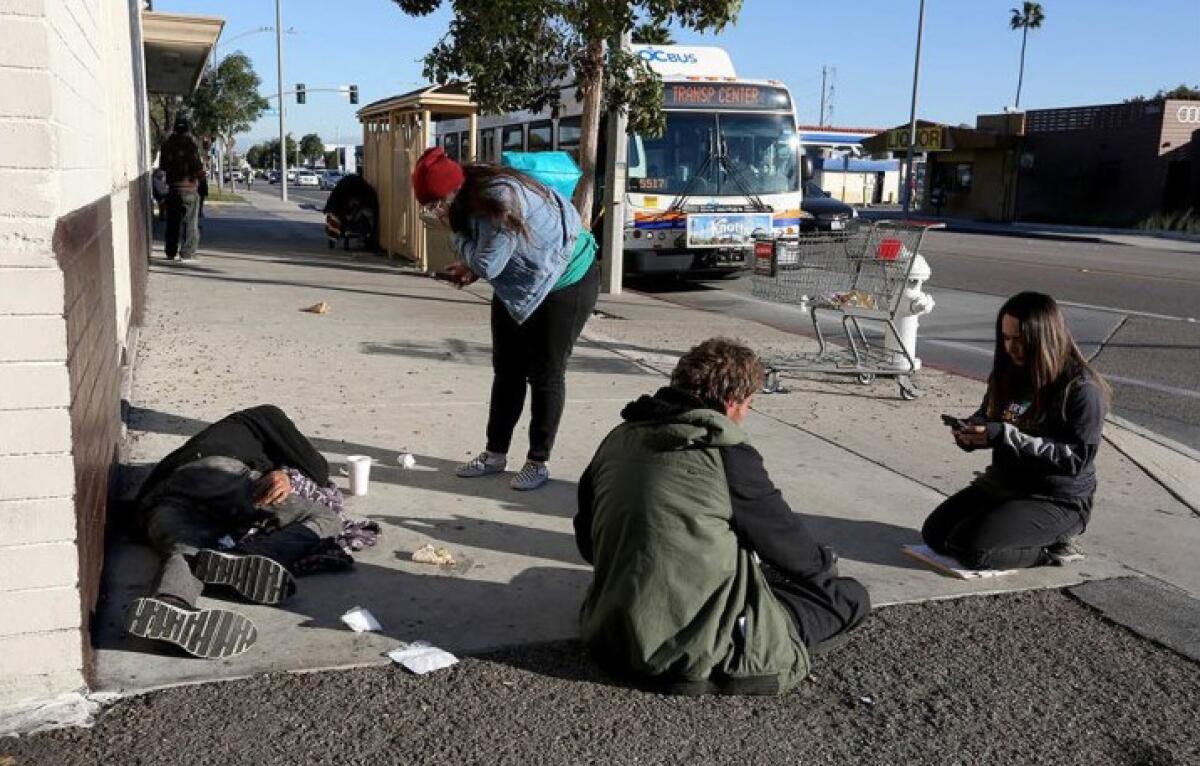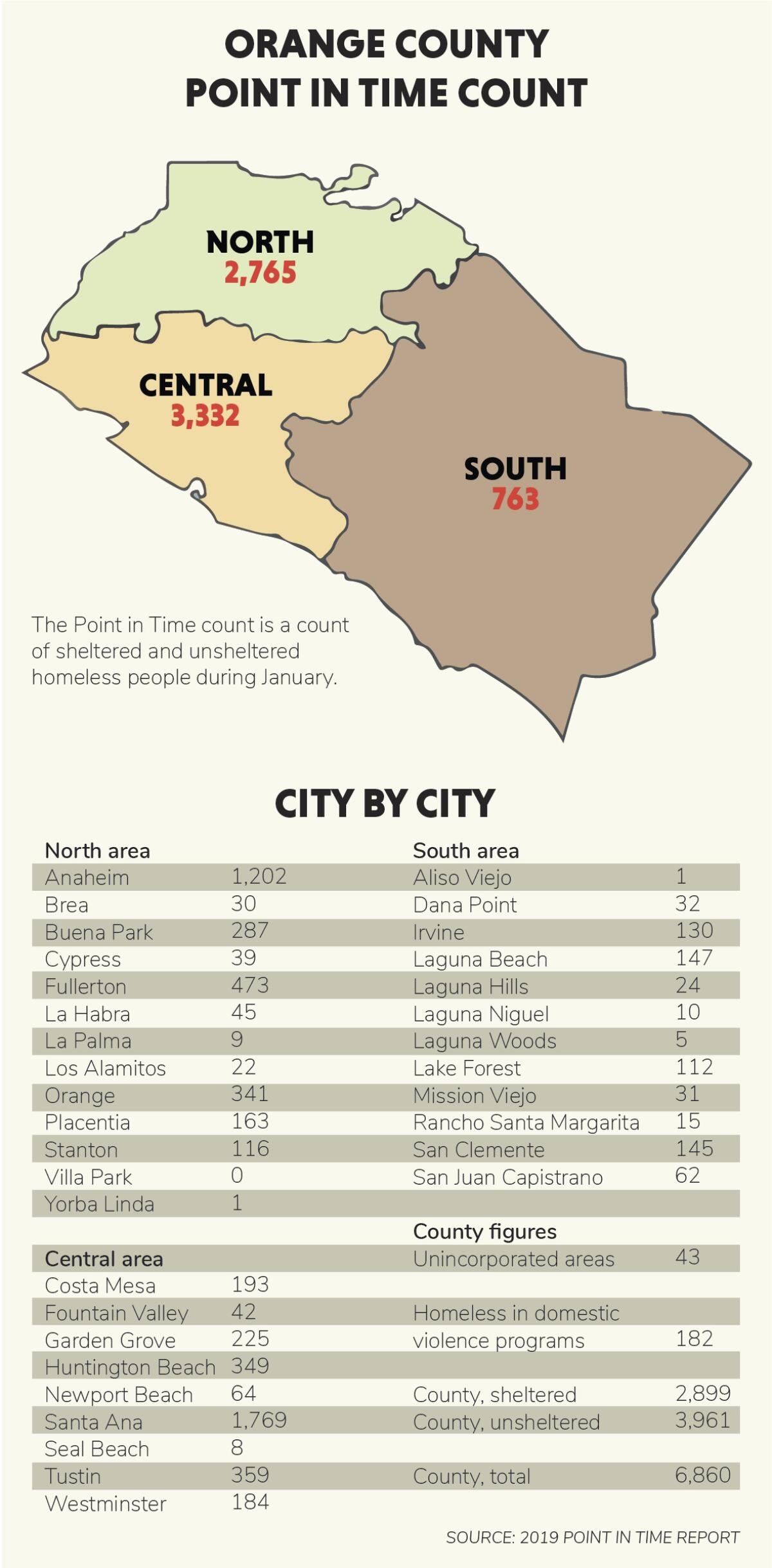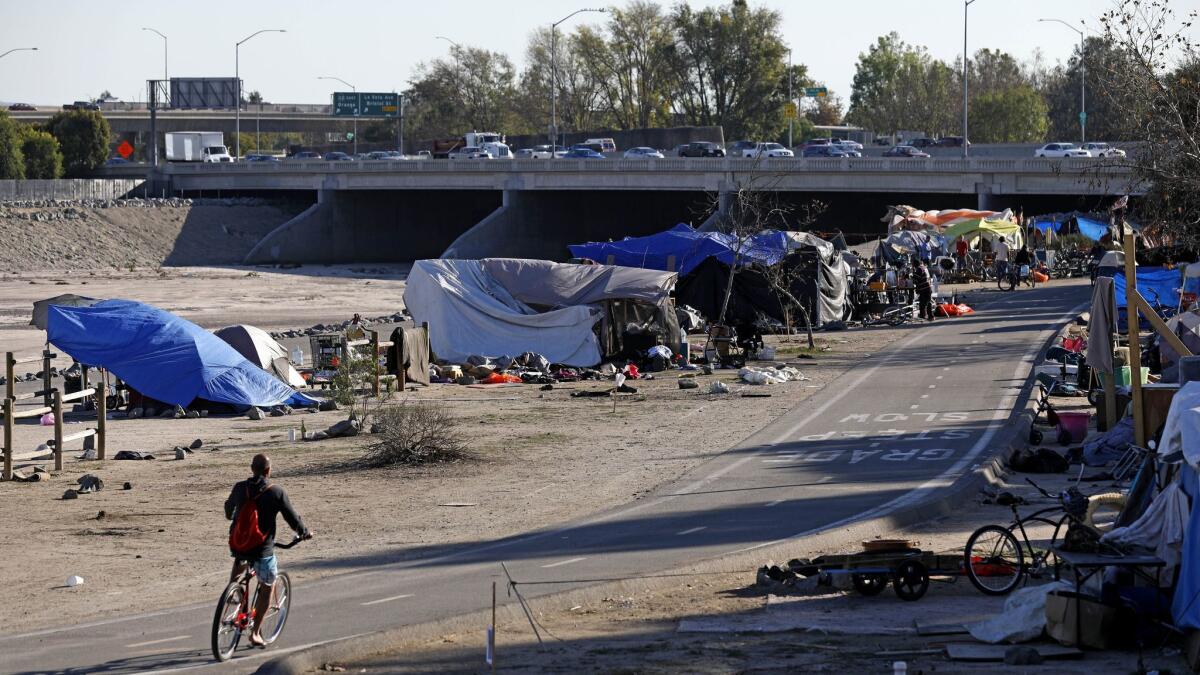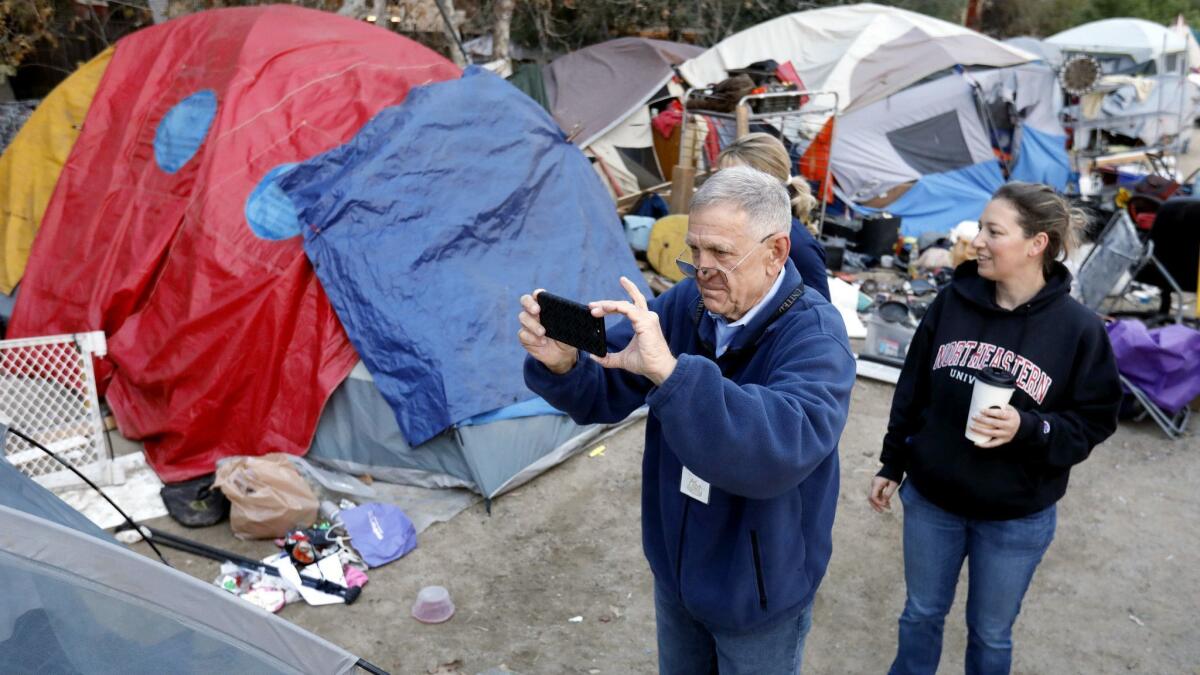Unsheltered, Part 1: Why does Orange County have a homeless problem and how can it be solved?

- Share via
Editor’s note: This is the first article of Unsheltered, a five-part series examining homelessness in the cities of Costa Mesa, Fountain Valley, Huntington Beach, Laguna Beach and Newport Beach. Though many private organizations and various levels of government are involved in the search for solutions, the series looks specifically at the problem in local cities, what they are doing about it and what more might be done. This installment examines some of the major factors that contribute to local homelessness, along with who and where homeless people are.
On a dreary morning about a year ago, almost 4,000 people were living with no roof over their heads in Orange County.
They instead found refuge wherever they could — huddled for warmth amid roadside shrubs in Westside Costa Mesa, camped under Newport Beach’s Balboa Pier, squeezed into the backseat of a van parked in Huntington Beach.
Individually, they couldn’t be more different. They hail from different walks of life. They’ve had different experiences. They face different challenges.
But all have a few things in common — the streets they call home and the stigmas and struggles they face as a result.
They are Orange County’s homeless — a group that, when you include those staying in shelters or other transient living situations, numbered 6,860 in January 2019 during the latest Point in Time count, which surveyed the county’s homeless population.
Collectively, they could be a city unto themselves, with a population larger than Villa Park and more than half that of Los Alamitos.
They are at once the county’s most vulnerable residents and its most pressing challenge.
The latest comprehensive census of Orange County’s homeless population found nearly 7,000 people living in shelters or on the streets countywide — a significant uptick from the last such count in 2017, according to results released Wednesday.
In recent years, homelessness has become an increasingly visible and talked-about issue. When a sprawling tent city mushroomed along the Santa Ana River trail in Anaheim — a stone’s throw from the Honda Center and Angel Stadium — it sparked headlines nationwide.
From the outside looking in, the homeless camp appeared to clash with the common characterization of Orange County as an archetype of sun-soaked, cozy affluence.
How, many seemed to wonder, had it come to this?
There isn’t a simple answer. Interviews with service providers, municipal leaders and advocates for the homeless paint a picture of a problem with complexity to match its magnitude.
“There’s no one reason for homelessness and there’s no one solution,” said John Begin, homelessness initiative director for Trellis, a Costa Mesa faith-based consortium that seeks to address significant local issues.
A lost job or a rent increase can be enough to push someone onto the street.
Others might end up homeless as a result of health issues or struggles with drug and alcohol addiction, or because they’ve recently been released from jail or had to flee an unstable or unsafe living situation.
Whatever an individual’s predicament, many of the officials, advocates and experts who spoke with the Daily Pilot agreed that getting arms around Orange County’s homelessness problem will take bold, cooperative efforts and leaders who are willing to see those through, even in the face of potentially fierce opposition.
Municipal officials often say they’re willing to do their “fair share.” What that means depends on whom you ask.
“There’s no one reason for homelessness and there’s no one solution.”
— John Begin, homelessness initiative director for Trellis
Relying on hundreds of pages of documents and dozens of interviews with local leaders, advocates, experts, public safety officials and homeless people, the Pilot is taking a comprehensive look at the issue in hopes of answering several critical questions:
How did we get here? What factors are fueling the growth in homelessness countywide? What might potential solutions look like?
And perhaps the most complicated questions: What role should cities play in addressing the problem? What is their “fair share”?
History
“County urged to give more assistance to the homeless.”
It’s a headline that wouldn’t look out of place today. However, the article — which begins, “The government of Orange County needs to do more to provide the housing, emergency shelters and monetary assistance the homeless need, the leader of the Orange County Coalition on the Homeless said” — appeared in the Los Angeles Times on Aug. 2, 1985.
Homelessness is far from a new issue in Orange County. So why is it seemingly grabbing public attention now like never before?
There are several reasons, experts and advocates say. First is the sheer magnitude of the issue. Recent surveys show significant increases in the number of people living on the streets.
The Point in Time count — a federally required biennial census of the homeless — recorded 4,792 such individuals throughout Orange County in January 2017, including 2,584 who were unsheltered, meaning they were staying in a place where people normally wouldn’t sleep regularly, such as on the street, in a park or in a vehicle.
Both of those numbers increased sharply in the most recent count last January, which tallied 6,860 homeless people, 3,961 of them unsheltered.
The remaining 2,899 homeless people documented in the latest survey were considered “sheltered,” meaning they had some kind of temporary roof over their heads. They may have been staying in an emergency shelter or been enrolled in a transitional housing program.

Many areas of the state saw increases in their homeless populations, but Orange County’s was among the steepest.
California is split into a number of so-called continuums of care — local planning bodies that work to coordinate homeless services within specific areas.
Of the state’s 15 largest continuums — those that cover areas with a population of at least 700,000 — Orange County had the fourth-largest proportional increase in its homeless population from 2017 to 2019. According to a final Point in Time count report released July 30, Orange County’s 43.2% increase was exceeded only by continuums covering Stockton/San Joaquin County, 70.5%; Bakersfield/Kern County, 64.2%; and Oxnard, San Buenaventura/Ventura County, 44.9%.
It isn’t just the size of Orange County’s homeless population that has changed but also where those people are. Historically, the county’s homeless seemingly have lived on the fringes of public consciousness — not necessarily out of sight, but largely out of mind.
That’s no longer the case. In recent years, homeless people have begun appearing in areas where they hadn’t typically been visible, at least not in large numbers.
The homeless have been in downtown Santa Ana for decades, “but the majority of the population didn’t see it unless they went to the courthouse or had to go get a document at the Civic Center. … It was kind of like, ‘Oh, that’s that problem in Santa Ana,’” said Helen Cameron, community outreach director for Jamboree Housing Corp., an Irvine-based developer of affordable and supportive housing.
“So when it became visible in other areas of the community and it began to be seen in parks … people felt violated,” she said. “They couldn’t use their own parks. They weren’t feeling safe.”
The 2019 homeless count reflected the dispersion. Of Orange County’s 34 cities, 16 had a homeless population of at least 100 — up from 12 two years before.
At the top end, the homeless numbered 1,769 in Santa Ana and 1,202 in Anaheim. Smaller cities such as Aliso Viejo and Yorba Linda had only one, and Villa Park had none.
The count found 349 homeless people (60 of them sheltered) in Huntington Beach; 193 (six sheltered) in Costa Mesa; 147 (76 sheltered) in Laguna Beach; 42 (14 sheltered) in Fountain Valley and 64 (none sheltered) in Newport Beach.
In each case, the numbers were higher than in the 2017 count, and every city except Fountain Valley saw at least a 56% increase in its documented homeless population.
The riverbed

The increase in the number of homeless probably came as no surprise to those who saw the scene along the Santa Ana River trail.
When officials, citing public safety and sanitation concerns, moved to clear the sprawling encampment, a handful of people living there sued the county as well as the cities of Costa Mesa, Anaheim and Orange.
The plaintiffs alleged that the cities, by enforcing local laws against camping, trespassing and loitering, had effectively criminalized homelessness and forced their homeless people to seek refuge in the riverbed. In moving to clear the camp, the plaintiffs claimed, the county was effectively pushing the homeless back into those communities without a plan to shelter them.
The case eventually triggered a seismic shift in Orange County’s homelessness landscape. The man doing most of the shaking was U.S. District Judge David Carter, who presided over the lawsuit.
From the beginning, Carter took a hands-on approach, making multiple trips to the riverbed and documenting the conditions with his cellphone camera. During conferences on the case, he repeatedly pushed city and county officials to develop additional transitional and emergency beds. He eventually set a target of having enough beds to serve 60% of the 2,584 unsheltered people tallied during the 2017 Point in Time count.

Those efforts received a major boost in September 2018, when the U.S. 9th Circuit Court of Appeals ruled that it is unconstitutional to prosecute homeless people for sleeping on public property when they don’t have access to shelter.
The decision in the case of Martin v. the city of Boise found that “as long as there is no option of sleeping indoors, the government cannot criminalize indigent, homeless people for sleeping outdoors on public property on the false premise [that] they had a choice in the matter.”
Two weeks ago, the U.S. Supreme Court declined to hear the case, meaning the 9th Circuit ruling stands.
It didn’t take long for that ruling to reverberate locally. Costa Mesa and Huntington Beach have cited it as part of their rationale for taking steps to develop local homeless shelters. Newport Beach also is considering opening a shelter.
“You’re going to see a lot more shelters go up in Orange County,” said Costa Mesa Mayor Pro Tem John Stephens. “I think ... within a year, there will be shelters complying with the city of Boise case in probably half the cities in Orange County. That’s just my guess.”
However, some advocates say new shelters — while welcome — are merely a Band-Aid for those who require ongoing care catered to their particular needs.
“The response is not, ‘Oh, let’s find out how to have permanent solutions for homelessness through housing,’” said Julia Devanthery, an attorney with the American Civil Liberties Union of Southern California. “The response has been, ‘How can we, as quickly as possible, make as many temporary shelters for people to sleep in so we can go back to criminalizing people who are not in those shelters?’”
Portrait of the homeless

But who are the people living on the streets? Information from the latest Point in Time count paints a general picture.
Of 2,146 unsheltered individuals who responded to informational surveys during the count, almost 52% said they were attending or have attended school in Orange County or have family here. About 72% reported they were currently working or had previously worked in the county.
Almost three-quarters said their last permanent address was in Orange County.
A June 2017 collaborative study by Jamboree Housing Corp., UC Irvine and the Orange County United Way titled “Homelessness in Orange County: The Costs to Our Community” concluded that “the vast majority of Orange County’s homeless, whether male or female,” had lived in the county for at least a decade.
Those findings don’t jibe with the perception of some that most homeless people are outsiders drawn to California by its agreeable weather or what they might consider its more permissive policies.
A man who goes by the name “Ghost” maintained a campsite under a structure at the public bus station in Newport Beach, at least before homeless people were cleared from the depot in September.
When interviewed in July, he said he had been there for two years, pushed to sleeping in the open after a tough divorce and the recession of a decade ago led to him losing his home in Costa Mesa. He said he was trapped by not being able to get a job without an address and vice versa.
He said he didn’t want that life — he wanted a job and a home.
Ghost, 58 at the time, said the influx of homeless people at the bus station happened “because they got kicked out of every other city they’ve been in.”
Addiction and mental health issues are commonly seen as factors driving homelessness. Of the 252 respondents in the United Way/UCI/Jamboree study, 22% said alcohol or drug use was a major contributor to their homelessness, while 17% cited mental health issues and 7% pointed to a release from jail or prison.
Forty percent said their homelessness was fueled at least in part by their inability to secure or keep a job with sustainable wages, and 36% said they’d had difficulty finding or retaining affordable housing. Twenty-eight percent cited family-related issues such as domestic violence, the end of a relationship or the death of a relative.
The study called the findings “revelatory in the sense that they shift the focus of attention from the often-repeated stereotypical causes of homelessness, namely mental illness and substance abuse, to the gap between the availability of affordable housing and work that pays a wage sufficient to enable the economically marginal to access that housing.”
“Most people tend to imagine the kind of worst-case scenario that everybody is homeless because they’ve been released from jail or prison, they have a mental health diagnosis, they’re an addict and an alcoholic and they came from New York,” said Becks Heyhoe, director of United to End Homelessness for Orange County United Way. “We sort of make it this kind of homogeneous group.”
Tenuous economic and social circumstances aren’t unique to the Golden State, but they can be particularly pronounced here, especially when it comes to affordable housing.
“While many factors have a role in driving California’s high housing costs, the most important is the significant shortage of housing, particularly within coastal communities,” according to a February report from the California legislative analyst’s office. “Today, an average California home costs 2.5 times the national average. California’s average monthly rent is about 50% higher than the rest of the country.”
Still, there’s little doubt that addiction and other health-related factors are significant contributors to homelessness. With the nation in the grip of a deadly opioid crisis, many people have traveled to cities such as Costa Mesa and Huntington Beach to seek treatment for their addictions. In some cases, those people have left or been kicked out of their sober-living or other recovery programs and ended up on their own with no way to get home.
Dawn Price, executive director of Friendship Shelter in Laguna Beach, said her organization has regularly worked to help people “who get sent here for rehab and then went into sober living and, for some reason, that fell apart and now they’re on the street.”
Reason for optimism?

Though the homelessness issue is immense in its scale and intricacy, advocates and experts say there’s light at the end of the tunnel.
In Heyhoe’s mind, a key to any discussion of how to end homelessness needs to include the question “How do we change the dialogue from ... despair and crisis to hope?”
“We can end homelessness,” she said. “This is Orange County, California. We have the resources, the intellect. We have everything we need to end homelessness here.”
Coming in Part 2: What’s being done to address homelessness?
Daily Pilot staff writers Lilly Nguyen and Julia Sclafani contributed to this report. Priscella Vega writes for the Los Angeles Times.
All the latest on Orange County from Orange County.
Get our free TimesOC newsletter.
You may occasionally receive promotional content from the Daily Pilot.






